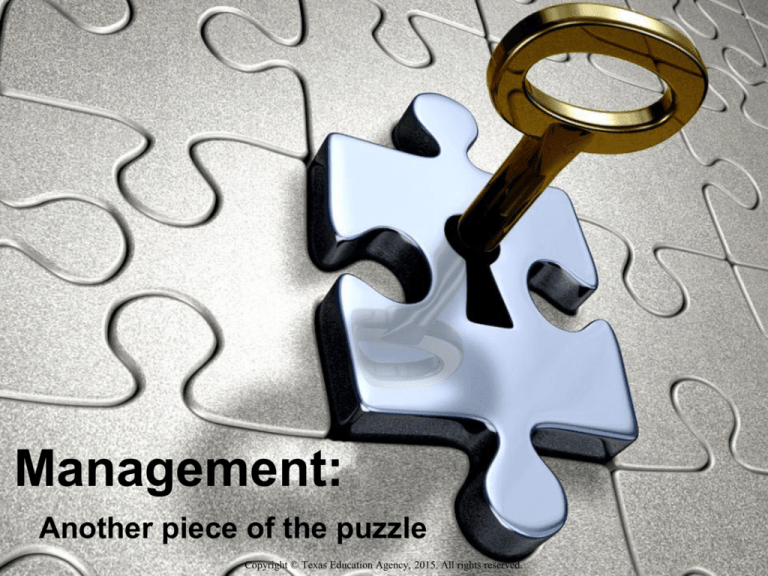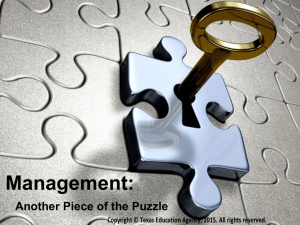
Management:
Another piece of the puzzle
Copyright © Texas Education Agency, 2015. All rights reserved.
Objectives
• Discuss the difference between traditional
and horizontal organization
• Identify the three levels of management
• Theorize how a self-managing team functions
• Defend the importance of management
• Evaluate the five functions of management
Copyright © Texas Education Agency, 2015. All rights reserved.
Terminology
• Vertical organization
Top to bottom management structure of an organization
(consists of Top, Middle, and Supervisory levels)
• Top management
Makes decisions affecting entire company; decisions have
broadest effect on the company
• Middle management
Implements the decisions of Top management; plan ways
to implement goals; communicate with Supervisory level
management
• Supervisory level management
Supervise the activities of employees; carry out the
instructions of middle and top management; assign tasks
and evaluate performance of employees
Copyright © Texas Education Agency, 2015. All rights reserved.
Terminology 2
• Horizontal organization
Self-managing teams set their own goals & make their
own decisions. Organized by process instead of function
• Empowerment
Encourages team members’ contributions and willingness
to take responsibility
• Managing
Completing the work of an organization through its
people and resources
• Organizing
Bringing people, activities and resources together for the
benefit of the company
Copyright © Texas Education Agency, 2015. All rights reserved.
Terminology 3
• Staffing
Matching workers with the tasks to be done
• Controlling
Measuring performance; comparing performance
with company objectives and goals for effective
outcome
• Long-range planning
Information is gathered and analyzed, serving goals
ranging from one to five years; or five to ten years
• Short-term planning:
Specific objectives are identified for implementation
of one year or less. Usually evaluated on quarterly
or semi-annual basis
Copyright © Texas Education Agency, 2015. All rights reserved.
Management Structures
A. Vertical Organization
Manager performs particular department function well
Top management
Middle management
Supervisory-level
B. Horizontal Organization
Became popular due to downsizing in 1980s & 1990s
Self-managing teams set own goals and
make own decisions
Customer oriented
Adopted by most manufacturers
Copyright © Texas Education Agency, 2015. All rights reserved.
Management Functions
A. Planning
Long range
Short term
B. Organizing
Arrange staff to accomplish goals
Organizational Chart
C. Controlling
Performance is measured and compared with goals
Setting standards, areas of improvement
D. Staffing
Recruit and hire; train; evaluate performance
E. Leading
Communicate direction of business;
commitment; motivation, drive
Copyright © Texas Education Agency, 2015. All rights reserved.
Management Styles
Autocratic:
Makes decisions with virtually no input
“My way or the highway”
Chaotic:
Allows employees to make all decisions
Can be a “circus”
Consultative:
Gets feedback and adjusts when necessary
Can be slow; Advisory board can be helpful
Copyright © Texas Education Agency, 2015. All rights reserved.
Management Styles
Democratic:
Allows majority rule; sometimes slow process
but easier to get employee’s approval
Laissez-faire:
Manager acts as a mentor;
Allows employees some control
Focus on results; not how work gets done
Persuasive:
Makes decision, then convinces employees it
was a good decision
Spends time getting people to “buy in”
Copyright © Texas Education Agency, 2015. All rights reserved.
An Effective Manager
• Shows a “Happy Face”
• It’s ok to smile! Its contagious!
• Cares about others
• Encourages and looks for the good in others
• Says “thank you”
• Is considerate
• Takes interest
• Calls people by their names
• Recognizes birthdays, anniversaries, etc.
• Listens
• Asks questions
• Recalls information
• Encourages interaction
• Does not gossip
• Treats everyone equally
• Is a team player
• Is trustworthy
Copyright © Texas Education Agency, 2015. All rights reserved.
An Effective Manager
• Handles disagreements quickly and fairly
• Resolves conflict
• Communicates clearly
• Written
• Oral
• Appreciates humor at appropriate times
• Humor alleviates stress
• Timing must be appropriate
• Is empathetic
• Walks in “others shoes” easily
• Isn’t negative and doesn’t whine
• Sets a good example
• Isn’t a “cry baby”
Copyright © Texas Education Agency, 2015. All rights reserved.
An Effective Manager also
A. Is able to give clear directions
B. Has skills to train employees adequately
C. Has vision
D. Is consistent and fair and firm
E. Acts as a good example
F. Delegates responsibilities
G. Fosters initiative
Copyright © Texas Education Agency, 2015. All rights reserved.
Application
for managers of Printing and Imaging projects
• Know the Technology and Terminology
• Being able to communicate clearly with designers
and printers saves time on projects and establishes
a good working environment
• This reduces the time and energy to produce the
project which can reduce costs
• Encourage Synergy
• Creativity breeds Creativity – as the saying goes,
“two heads are better than one”
• Positive feedback will produce a better project and
a better working team
Copyright © Texas Education Agency, 2015. All rights reserved.








